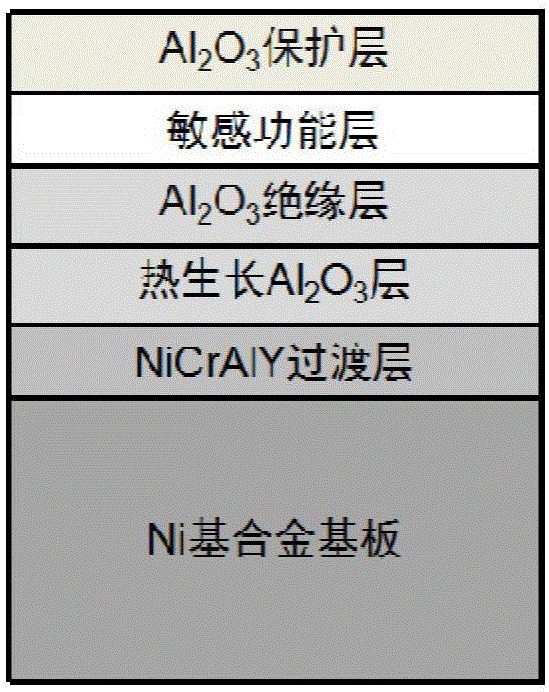Antioxidant composite protective layer for high-temperature film sensor and manufacturing method of antioxidant composite protective layer
A thin film sensor, anti-oxidation technology, applied in coatings, protection equipment, high-efficiency propulsion technology, etc., can solve the problems of device failure, reliability reduction, application temperature range limitation, etc., achieve excellent high temperature insulation performance, meet insulation requirements, good heat matching effect
- Summary
- Abstract
- Description
- Claims
- Application Information
AI Technical Summary
Problems solved by technology
Method used
Image
Examples
Embodiment
[0038] Such as image 3 As shown, the sectional view of the tungsten-rhenium thin film sensor based on the anti-oxidation composite protective layer of the present invention provided for the embodiment; from bottom to top are Ni-based alloy substrate 1, NiCrAlY alloy transition layer 2, thermal growth Al 2 o 3 Layer 3, Al 2 o 3 Insulating layer 4, first BN insulating layer 5, tungsten-rhenium thin film thermocouple positive and negative electrodes 6, second BN insulating layer 7, ZrB 2 matrix composite ceramic layer 8, Al 2 o 3 Overlay 9.
[0039] The preparation method of the tungsten-rhenium thin film sensor based on the anti-oxidation composite protective layer of the present invention provided in the embodiment specifically includes the following steps:
[0040] Step 1. Surface treatment of the Ni-based alloy substrate: first, polish the surface of the Ni-based alloy substrate, then use industrial degreaser, acetone, alcohol and deionized water to ultrasonically clea...
PUM
| Property | Measurement | Unit |
|---|---|---|
| thickness | aaaaa | aaaaa |
| thickness | aaaaa | aaaaa |
| thickness | aaaaa | aaaaa |
Abstract
Description
Claims
Application Information
 Login to View More
Login to View More - R&D
- Intellectual Property
- Life Sciences
- Materials
- Tech Scout
- Unparalleled Data Quality
- Higher Quality Content
- 60% Fewer Hallucinations
Browse by: Latest US Patents, China's latest patents, Technical Efficacy Thesaurus, Application Domain, Technology Topic, Popular Technical Reports.
© 2025 PatSnap. All rights reserved.Legal|Privacy policy|Modern Slavery Act Transparency Statement|Sitemap|About US| Contact US: help@patsnap.com



